Four roads cut through the Coastal Mountain Range in Taiwan’s east. From north to south, they are: Highway 11A (台11甲線); Hualien County Road 64 (花64線), sometimes called Ruigang Industry Road (瑞港產業道路); the newish Highway 30 (台30線), also known as the Yuchang Highway (玉長公路); and Highway 23 (台23線).
A determined walker could tramp the length of any of the first three roads in a single day. For cyclists and hikers, however, the southernmost route is a significantly greater challenge.
The distance from the inland end of Highway 23 in Hualien County’s Fuli Township (富里鄉) to its western terminus, on the coast in Taitung County’s Donghe Township (東河鄉), is 45.5km. What’s more, a good bit of it is uphill. Fuli Railway Station (富里火車站) is at an elevation of 227m, while the highest point on the road — which also happens to be the border between the counties of Hualien and Taitung — is 637m above sea level.
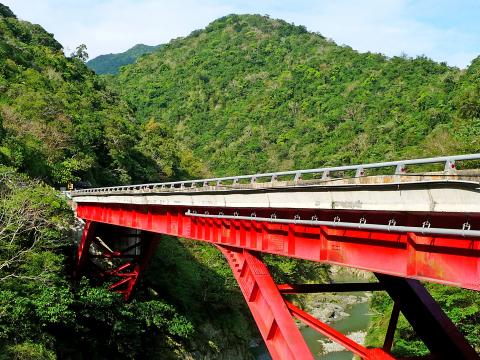
Photo: Steven Crook
This perhaps explains why, when we drove from Fuli to Donghe a few weeks back, we didn’t see a single cyclist, despite the weather being just about perfect for a long bike ride.
If going all the way to the coast doesn’t fit in with your plans, but you find yourself in the vicinity of Fuli, do make an effort to drive or ride part of Highway 23. Excellent scenery can be found less than 4km up the road.
Turning a corner as we approached the two-church village of Fengnan (豐南), we were treated to an entrancing combination of rice paddies and steep green hills. Surprisingly, nobody seems to have thought of marketing this area as “Little Guilin” (小桂林). For those who don’t know it, Guilin is one of the most famous scenic attractions in China.
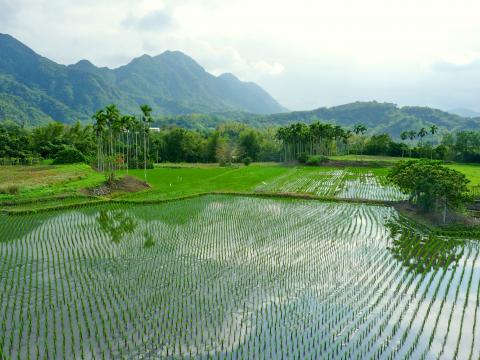
Photo: Steven Crook
It’d be hyperbole — but no more unreasonable than other claims made by the tourism industry. Also, it would cancel out the unappealing names given to two remote locations near Fengnan: One is called Choushuigou (臭水溝, “Stinky Water Ditch”), the other Wenzidong (蚊子洞, “Mosquito Hole”).
Those traveling all the way to Donghe should bear in mind that beyond Fengnan, there’s very little chance of being able to order a bowl of noodles, or buy soft drinks, until you reach Taiyuan (泰源), a good 30km away. We had our lunch at the village’s only eatery, next door to a shop that oozed retro appeal. Alongside the usual dried and canned goods and bottled drinks, the latter sells seasonal homemade products like pickled chillis.
The noodle restaurant and shop are easy to find. They’re right beside Highway 23, directly across the road from the Roman Catholic church that was built in 1962.
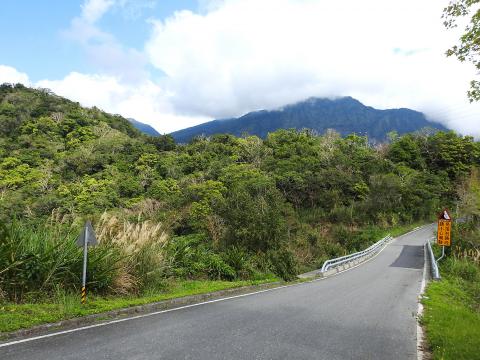
Photo: Steven Crook
Just up the road, around the 7km-marker, there’s a spot dubbed Little Tiansiang (小天祥). It doesn’t have the scale or majesty of the canyon near Tiansiang in Taroko Gorge (太魯閣) — which is why relatively few people have heard of it — but it does deserve several minutes of your time. As in Taroko Gorge, the road is narrow, so take care not to block the road if stopping.
Every turn on Highway 23 is a visual pleasure, but the section just before and after the Hualien-Taitung boundary near km16.5 justifies a certain overused adjective: breathtaking. Even after the road crests, it’s a long time before you get to see the Pacific Ocean. There are too many mountains in the way, and some towering cliffs.
After the 25km-marker, approaching Donghe Farm (東河農場), we saw more signs of human habitation. Down in the valley to our right, there were farmsteads and another Catholic house of worship.
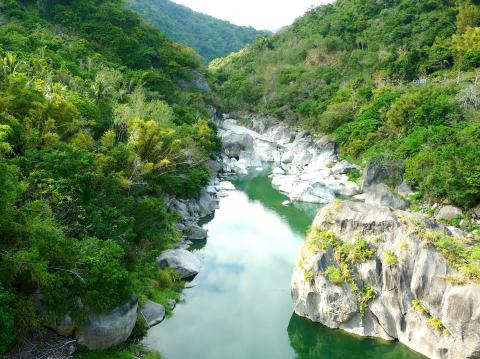
Photo: Steven Crook
The population density was a little higher around Beiyuan (北源), beyond the 35km-marker. The largest buildings hereabouts belong to Taiyuan Skills Training Institute (泰源技能訓練所), which (despite the benevolent sound of its name) is a correctional facility. During the Martial Law era (1949 to 1987), this complex held political prisoners, some of whom launched an unsuccessful uprising in 1970.
Taiyuan, 3km down the road from the prison, isn’t much of a town, but it does have a few restaurants and at least one guesthouse. Instead of stopping there, we halted three minutes to the south at Dengsian Bridge (登仙橋).
Bilingual signs at both ends of the bridge ask tourists not to feed the Formosan macaques which gather there. When we stopped, however, the eight or nine monkeys hanging around were all tucking into oranges which looked very similar to those a man was hawking from the back of his truck.
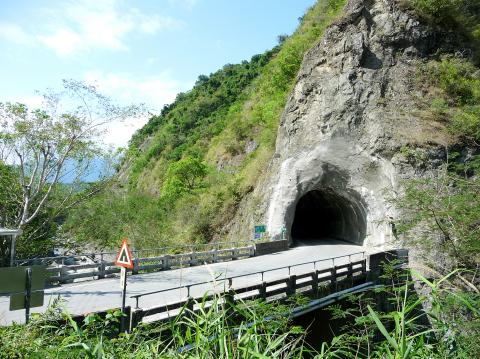
Photo: Steven Crook
Where Highway 23 hits Highway 11, the coast road connecting Hualien City and Taitung City, two bridges cross Mawuku Creek (馬武窟溪). From the Old Donghe Bridge (舊東河橋), now closed to vehicles, the view upriver is captivating. In fact, if any point along Highway 23 deserves to be compared to Taroko Gorge, it’s this one.
The valley combines green forest, white rock, and serpentine water. Hoping to see it from a different angle, I took the well-maintained pathway at the southern end of the old bridge down to the water’s edge. Instead of going upriver, it lead me under the old bridge, then the new bridge, and eventually to the seashore. But I wasn’t disappointed. In this part of Taiwan, it’s not merely all good.
It’s fantastic.
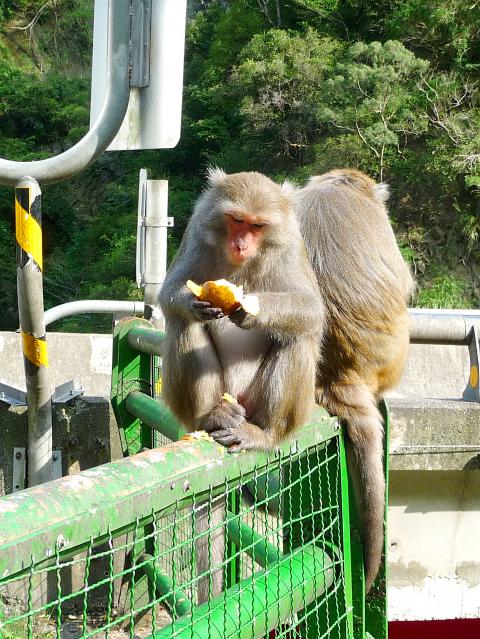
Photo: Steven Crook
Steven Crook has been writing about travel, culture, and business in Taiwan since 1996. He is the co-author of A Culinary History of Taipei: Beyond Pork and Ponlai, and author of Taiwan: The Bradt Travel Guide, the third edition of which has just been published.
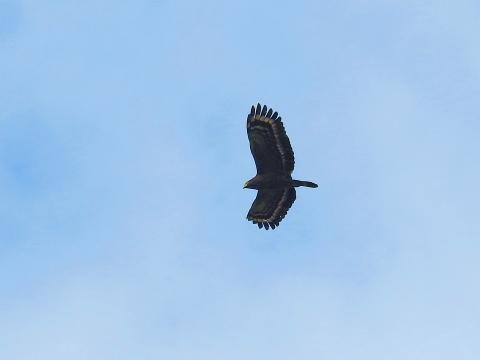
Photo: Steven Crook

Behind a car repair business on a nondescript Thai street are the cherished pets of a rising TikTok animal influencer: two lions and a 200-kilogram lion-tiger hybrid called “Big George.” Lion ownership is legal in Thailand, and Tharnuwarht Plengkemratch is an enthusiastic advocate, posting updates on his feline companions to nearly three million followers. “They’re playful and affectionate, just like dogs or cats,” he said from inside their cage complex at his home in the northern city of Chiang Mai. Thailand’s captive lion population has exploded in recent years, with nearly 500 registered in zoos, breeding farms, petting cafes and homes. Experts warn the

The unexpected collapse of the recall campaigns is being viewed through many lenses, most of them skewed and self-absorbed. The international media unsurprisingly focuses on what they perceive as the message that Taiwanese voters were sending in the failure of the mass recall, especially to China, the US and to friendly Western nations. This made some sense prior to early last month. One of the main arguments used by recall campaigners for recalling Chinese Nationalist Party (KMT) lawmakers was that they were too pro-China, and by extension not to be trusted with defending the nation. Also by extension, that argument could be

Aug. 4 to Aug. 10 When Coca-Cola finally pushed its way into Taiwan’s market in 1968, it allegedly vowed to wipe out its major domestic rival Hey Song within five years. But Hey Song, which began as a manual operation in a family cow shed in 1925, had proven its resilience, surviving numerous setbacks — including the loss of autonomy and nearly all its assets due to the Japanese colonial government’s wartime economic policy. By the 1960s, Hey Song had risen to the top of Taiwan’s beverage industry. This success was driven not only by president Chang Wen-chi’s

Last week, on the heels of the recall election that turned out so badly for Taiwan, came the news that US President Donald Trump had blocked the transit of President William Lai (賴清德) through the US on his way to Latin America. A few days later the international media reported that in June a scheduled visit by Minister of National Defense Wellington Koo (顧立雄) for high level meetings was canceled by the US after China’s President Xi Jinping (習近平) asked Trump to curb US engagement with Taiwan during a June phone call. The cancellation of Lai’s transit was a gaudy